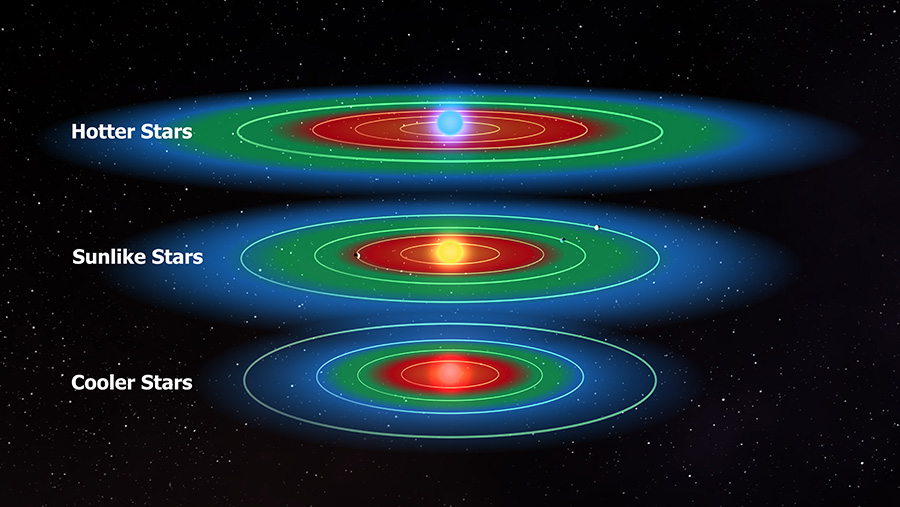1.05.2023
Scientists are refining the definition of the habitable zone in an effort to aid future efforts at finding life.

Artist's concept of an Earth-size planet in the habitable zone.
NASA / Ames / JPL-Caltech
The so-called habitable zone is the region around a star where, if a planet had an atmosphere, its surface temperature would be just right for liquid water to exist. Yet even though the habitable zone is where many astronomers focus their efforts, its very definition is still being refined.
In a study to appear in Astrophysical Journal Letters (preprint available here), Cassandra Hall (University of Georgia) and colleagues identify in what part of the habitable zone (HZ) photosynthesis can occur. This region is the most likely to host planets capable of producing the key signs of life known as biosignatures, Hall and colleagues write, which will aid in efforts to home in on habitability.

NASA / Kepler Mission / Dana Berry
A HABITABLE ZONE FOR PHOTOSYNTHESIS
All life as we know it depends on photosynthesis, directly or indirectly. So Hall’s team establishes a definition of the photosynthetic zone (PZ), in which photosynthetic processes would create more oxygen than they consume. The definition takes into account things like atmospheric attenuation, which governs how much light suitable for photosynthesis could reach a planet’s surface.
Hall’s team explores nine scenarios, varying the quality of conditions. Where the PZ and HZ overlap in each case creates the photosynthetic habitable zone (PHZ), wherein liquid water and photosynthesis could coexist. In the most favorable conditions, they find that the PHZ is nearly as broad as the HZ; in the most pessimistic conditions, they find that the PHZ doesn’t exist at all.
Five planets — Kepler-452 b, Kepler-1638 b, Kepler-1544 b and Kepler-62 e and f — consistently lie within the PHZ under multiple scenarios, so the researchers advise that these are the best places for biosignature searches. Although the five are fascinating, the real excitement stems from the PHZ itself, a new concept to be explored as we divvy up resources to look for life. 
Hall’s study investigates the effect of a variety of conditions on the presence of the photosynthetic habitable zone (green), defined as where the photosynthetic zone (pink) and the habitable zone (blue) overlap. If the atmosphere filters out too much light, conditions for life worsen; on the other hand, as plants’ respiration rate (R) decreases, organisms use less of the resources available because the conditions for life improved. The most optimistic scenario is presented in the bottom right panel, in which 21 rocky planets (that is, worlds with radii less than 1.8 times Earth’s) reside in the PHZ.
Hall et al. / arXiv:2301.13836
“I think a concept like this would be quite useful when we have observations of Earth-like exoplanet atmospheres,” says Ravi Kopparapu (NASA Goddard), who was not involved in the study. Planets residing in the PHZ, for example, might be more likely to show biosignatures. “I would, however, still use the traditional habitable zone when looking for target exoplanets… we want to make sure we can cast as wide a net as possible.”
HOMING IN
Hall’s efforts are not the only ones to optimize the search for biosignatures. Scientists have previously labeled portions of the HZ as “conservative” and “optimistic” to aid our understanding of any given planet’s habitability. And since each planet is different, studies have investigated everything from HZs around binary stars to questions about how planetary mass affects prospects for life.
Other research has examined what intelligent life would need to thrive. A 2019 study by Edward Schwieterman (University of California, Riverside) and collaborators was the first to estimate the HZ for animal-like life by considering the concentration of toxic gases, such as carbon monoxide, that different organisms on Earth can handle. This HZ version is much narrower than the canonical Goldilocks zone, but informative. Kopparapu says Hall’s study is complementary to the 2019 study, as both have implications on where different kinds of life could arise.
The formation of new concepts, such as the PHZ or the HZ for complex life, inform not only where we look, but also what tools we need as we search.
Quelle: Sky&Telescope
